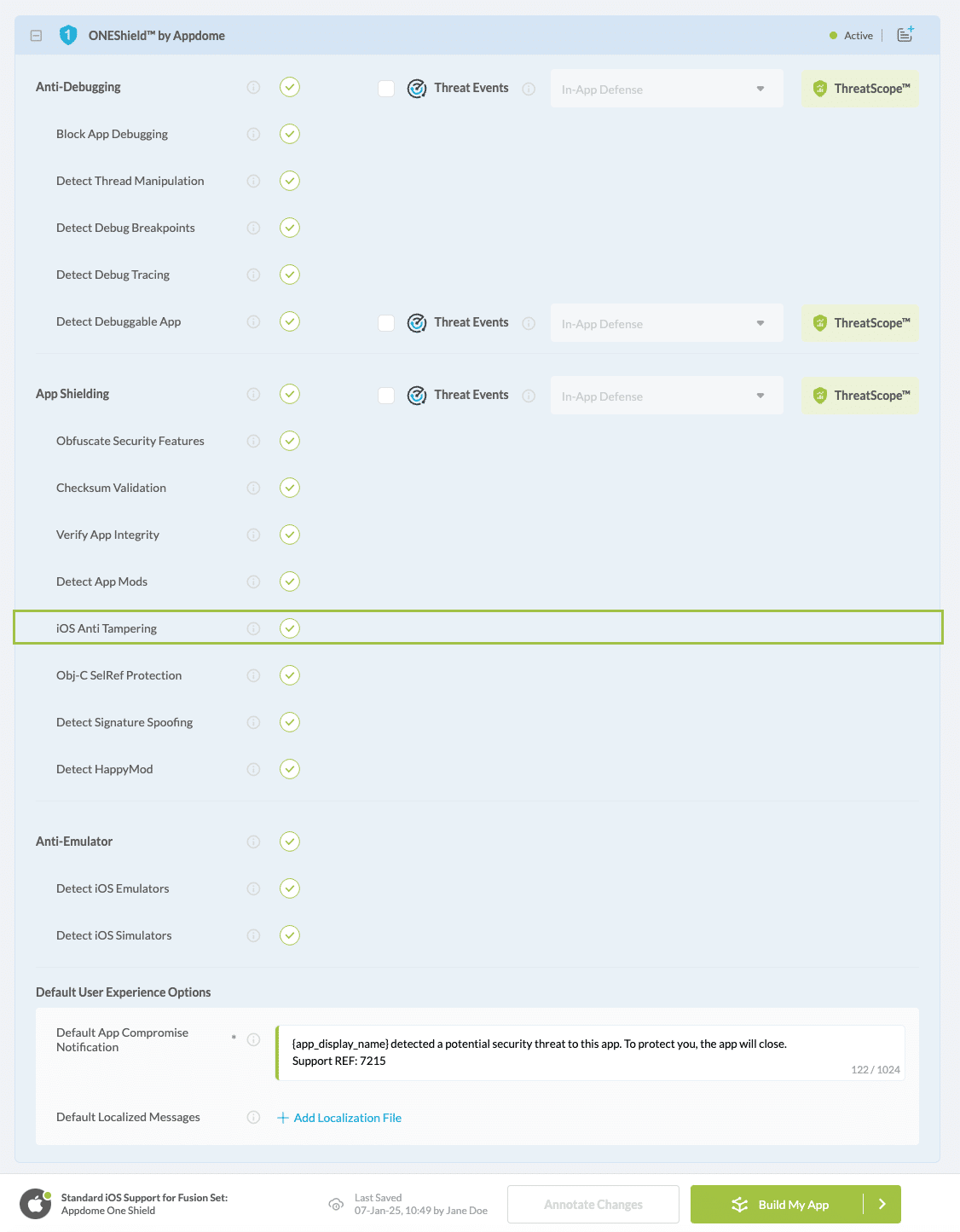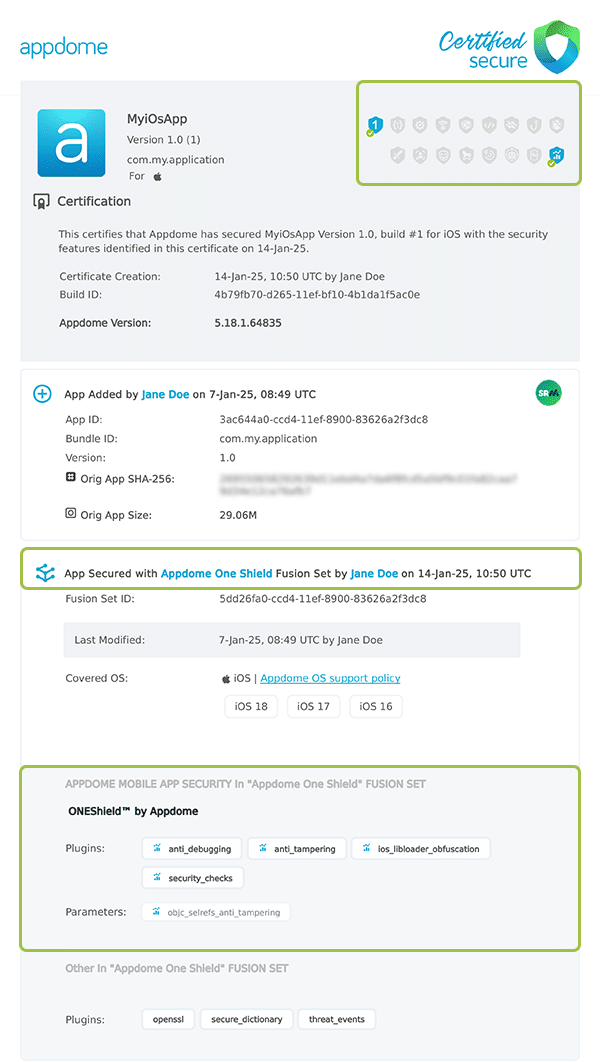How to use Appdome's OneShield Anti-Tampering in iOS Apps
This Knowledge Base article describes how to use Appdome’s AI/ML in your CI/CD pipeline to continuously deliver plugins that Enforce iOS Anti-Tampering in iOS apps.
What is iOS App Tampering?
iOS App Tampering refers to unauthorized alterations of an app’s binary, runtime behavior, or operating environment, often requiring a jailbroken device. Common methods include injecting malicious code or libraries using tools like Frida, bypassing security features, or repackaging the app with modified functionality. These actions can compromise the app’s security, exposing sensitive data, enabling unauthorized access, or violating the app’s intended behavior.
Why Anti-Tampering is Essential for iOS Apps?
For iOS apps, tampering can undermine the app’s integrity, leading to potential security risks and unintended behavior, especially on jailbroken devices. Without anti-tampering protection, malicious modifications could bypass key security features or compromise app performance. Anti-tampering ensures that iOS apps remain secure, functional, and resistant to exploitation, preserving the app’s intended behavior and protecting user data.
Prerequisites for Using Appdome's iOS Anti-Tampering Plugins:
To use Appdome’s mobile app security build system to Enforce iOS Anti-Tampering , you’ll need:
- Appdome account (create a free Appdome account here)
- A license for iOS Anti-Tampering
- Mobile App (.ipa for iOS)
- Signing Credentials (see Signing Secure Android apps and Signing Secure iOS apps)
How to Implement Enforce iOS Anti-Tampering in iOS Apps Using Appdome
On Appdome, follow these simple steps to create self-defending iOS Apps that Enforce iOS Anti-Tampering without an SDK or gateway:
-
Designate the Mobile App to be protected.
-
Upload an app via the Appdome Mobile Defense platform GUI or via Appdome’s DEV-API or CI/CD Plugins.
-
iOS Formats: .ipa
-
iOS Anti-Tampering is compatible with: Obj-C, Java, Swift, Flutter, React Native, Unity, Xamarin, Cordova and other iOS apps.
-
-
Select the defense: iOS Anti-Tampering.
-
-
Follow the steps in Sections 2.2-2.2.2 of this article to add the iOS Anti-Tampering feature to your Fusion Set via the Appdome Console.
-
When you enable App Shielding you'll notice that the Fusion Set you created in step 2.1 now bears the icon of the protection category that contains iOS Anti-Tampering.

Figure 2: Fusion Set that displays the newly added iOS Anti-Tampering protection
Note: Annotating the Fusion Set to identify the protection(s) selected is optional only (not mandatory). -
Open the Fusion Set Detail Summary by clicking the “...” symbol on the far-right corner of the Fusion Set. Copy the Fusion Set ID from the Fusion Set Detail Summary (as shown below):

Figure 3: Fusion Set Detail Summary
-
Follow the instructions below to use the Fusion Set ID inside any standard mobile DevOps or CI/CD toolkit like Bitrise, Jenkins, Travis, Team City, Circle CI or other system:
-
Refer to the Appdome API Reference Guide for API building instructions.
-
Look for sample APIs in Appdome’s GitHub Repository.
-
Create and name the Fusion Set (security template) that will contain the iOS Anti-Tampering feature as shown below:
Figure 1: Fusion Set that will contain the iOS Anti-Tampering feature
-
-
Add the iOS Anti-Tampering feature to your security template.
-
Navigate to Build > Security tab > ONEShield™ section in the Appdome Console.Like all other options in ONEShield™, iOS Anti-Tampering is turned on by default, as shown below:

Figure 4: Selecting iOS Anti-Tampering
Note: The App Compromise Notification contains an easy to follow default remediation path for the mobile app end user. You can customize this message as required to achieve brand specific support, workflow or other messaging. -
Configure the User Experience Options for iOS Anti-Tampering:
With Threat-Events™ OFF, Appdome provides several user experience options for mobile brands and developers.- App Compromise Notification: Customize the pop-up or toast Appdome uses to notify the user when a threat is present while using the protected mobile app.
- Short message Option. This is available for mobile devices that allow a banner notification for security events.
-
Localized Message Option. Allows Appdome users to support global languages in security notifications.

Figure 5: Default User Experience Options for Appdome’s iOS Anti-Tampering
-
iOS Anti-Tampering Threat Code™. Appdome uses AI/ML to generate a unique code each time iOS Anti-Tampering is triggered by an active threat on the mobile device. Use the code in Appdome Threat Resolution Center™ to help end users identify, find and resolve active threats on the personal mobile devices.
-
Congratulations! The iOS Anti-Tampering protection is now added to the mobile app -
-
Certify the iOS Anti-Tampering feature in iOS Apps
After building iOS Anti-Tampering, Appdome generates a Certified Secure™ certificate to guarantee that the iOS Anti-Tampering protection has been added and is protecting the app. To verify that the iOS Anti-Tampering protection has been added to the mobile app, locate the protection in the Certified Secure™ certificate as shown below:

Figure 6: Certified Secure™ certificate
Each Certified Secure™ certificate provides DevOps and DevSecOps organizations the entire workflow summary, audit trail of each build, and proof of protection that iOS Anti-Tampering has been added to each iOS app. Certified Secure provides instant and in-line DevSecOps compliance certification that iOS Anti-Tampering and other mobile app security features are in each build of the mobile app.
Using Appdome, there are no development or coding prerequisites to build secured iOS Apps by using iOS Anti-Tampering. There is no SDK and no library to code or implement in the app and no gateway to deploy in your network. All protections are built into each app and the resulting app is self-defending and self-protecting.
Releasing and Publishing Mobile Apps with iOS Anti-Tampering
After successfully securing your app by using Appdome, there are several available options to complete your project, depending on your app lifecycle or workflow. These include:
- Customizing, Configuring & Branding Secure Mobile Apps.
- Deploying/Publishing Secure mobile apps to Public or Private app stores.
- Releasing Secured Android & iOS Apps built on Appdome.
Related Articles:
- How to Automatically Validate Android and iOS App Logic & File Structure in CI/CD
- How to Prevent Android Apps from Running on Emulators
- How to Detect Player Emulators & Modding Platforms in Android Apps
- How to Prevent iOS Apps from Running on Emulators
How Do I Learn More?
If you have any questions, please send them our way at support.appdome.com or via the chat window on the Appdome platform.
Thank you!
Thanks for visiting Appdome! Our mission is to secure every app on the planet by making mobile app security easy. We hope we’re living up to the mission with your project.
